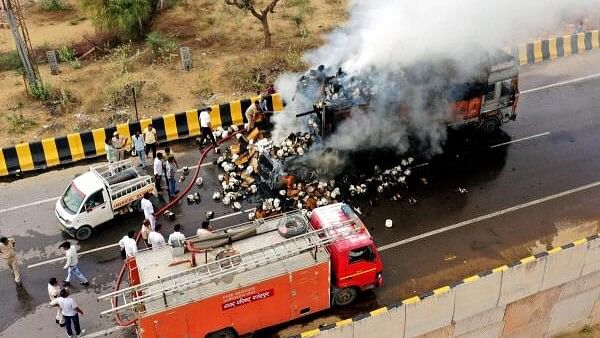
Police personnel investigate after a collision between a truck and a car, in Sikar district, Sunday, April 14, 2024.
Credit: PTI Photo
Road accidents are on the rise in India. Though deaths from road accidents globally are down by five per cent, the numbers are up in India. What makes this problematic is that India already has high numbers.
As per the National Crimes Record Bureau (NCRB) report, among the significant causes of accidental deaths in India — road, railway, and railway crossing accidents are the most important. Road accidents account for 97.3 per cent of the total accidents. A total of 68,236 road accidents were reported in 53 cities of India in 2022, in which 17,680 persons lost lives. A further analysis shows that most accidents occur near residential areas (29.1 per cent), industrial areas (10 per cent), and schools, with the city of Delhi reporting 50per cent. Pedestrians, two-wheelers, and cyclists show a higher risk and close to 40per cent of road accident deaths in metros are of pedestrians.
Globally, around 53 per cent of all road traffic fatalities are of vulnerable road users — pedestrians (23 per cent), those riding two-wheelers or three-wheelers (21 per cent), cyclists (6 per cent), followed by micro-mobility users including e-scooters. According to the Global Status Report on Road Safety by the World Health Organization, 2023, nine in 10 deaths occurred in low and middle-income countries, and fatalities in these countries are disproportionately higher when set against the number of vehicles and roads they have.
Why are more deaths experienced in low- and middle-income countries, and why are pedestrians the most vulnerable?
As per recent WHO data, 80 per cent of the world's roads fail to meet pedestrian safety standards, and only 0.2 per cent have cycle lanes and paths, leaving these road users vulnerable. The growth trend of motor vehicles is global and is expected to double by 2030. The mode of transport is an essential variable in road safety, not just in terms of risk to occupants but also in the danger it poses to other road users.
In Indian cities, roads are occupied by diverse modes of transport, which is much more significant than in other countries. Buses, cars, cycles, autorickshaws, cycle rickshaws, scooters, two-wheelers, pedestrians, and animal-driven vehicles and animals co-exist on Indian roads. It's a no-brainer to say that heavy motor vehicles and cars pose a higher risk than autorickshaws or two-wheelers.
Vulnerability to traffic accidents and limited access to roads is linked to class and caste differentials. The poorest are in the most danger and have the least access. If the working classes had the power to determine how the roads, road safety, and design of cities should be done, they would indeed be looking to champion a different model — and indeed a more sustainable, inclusive one which promotes walking and pedestrian paths, cycle tracks, public transport, and closer accessibility to residence, and to shops and public commons.
We must address social and economic issues, the technological environments, and the power available to people to influence decision-making regarding their well-being in planning mobility and transport in our cities. We import almost all the technological products and processes from highly-motorised countries, where cars are given too much importance.
Road accidents should be considered a public health domain, and we must consider the layered vulnerabilities and marginalisation that people face when devising and designing strategies. Thus, we must consider the most vulnerable road users while planning, designing, and constructing roads, and designing vehicles. When planning cities, we need an overall mobility plan focusing on people — not vehicles.
In a welcome move, the Government of India has announced a pilot project to provide cashless treatment of up to Rs 1.5 lakh to all victims of road accidents, but much more needs to be done to address the causes of road accidents. We need to explore multiple solutions. Some have been tried or experimented with — cycle lanes, bus rapid transport systems or corridors, elevated paths, and accessible and disabled-friendly pedestrian paths with lighting.
Then there is also the issue of vendors, hawkers, and pavement dwellers who either earn their livelihood on the roads or are forced to sleep there, and, therefore, point to the broader need for vending zones in proximity, as well as social housing options to resolve the issue of pavement dwellers. One of the questions on road safety is that of women's safety, which is especially crucial as roads and public spaces continue to be dominated by men. With lighting and response systems and bystanders’ support, this needs urgent action to ensure safety.
No silver bullet exists to ensure road safety. As mobility is crucial to cities, we need strategic solutions that consider the needs of the most vulnerable road users — people on foot, on cycles, and two-wheelers.
(Sandeep Chachra is Executive Director, ActionAid Association. Tikender Panwar is former Deputy-Mayor of Shimla.)
Disclaimer: The views expressed above are the author's own. They do not necessarily reflect the views of DH.